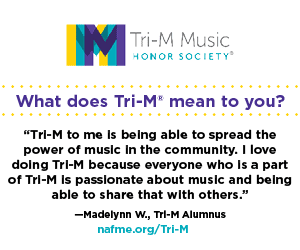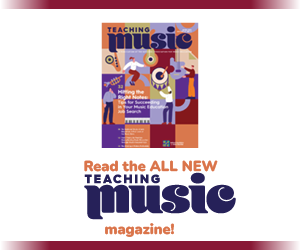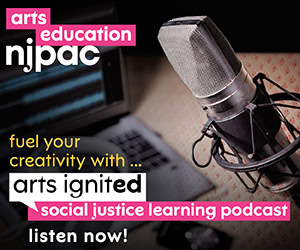/ News Posts / The Power of Music: But What Kind?
The Power of Music
But What Kind?
By NAfME Member Chiao-Wei Liu
This article was first published in the April 2023 issue of Journal of General Music Education.
One of the enchanting powers of music is its ability to transcend language and culture and capture complex human experiences. But music, rather than a mere reflection of social reality, also constitutes within discursive practices and contributes to the social construction of gender and sexuality. By looking at two different examples of music works, I call attention to the social-political role music plays in our life. I argue that attending to the sociopolitical perspective of music is to understand how music traverses across lives (and materials) and creates different relationships with and among us. This is an attempt to better comprehend human experiences, through which, we may repair and recreate new relationships. I end this column with a few curriculum ideas.
Many would agree with the statement that one of the enchanting powers of music is its ability to transcend language and culture and capture complex human experiences. For example, a third-grade student is highly capable of identifying the feelings expressed in Dido’s lament (when I’m laid in earth), even if the student is not familiar with the culture or language (English, in this case). With word painting, descending chromatic line and slow tempo in minor keys, the music creates a somber mood and delivers in depth the character’s internal feelings of sorrow and despair beyond the lyrical expression. The aria ends with the last “remember me” leaping in register on a sudden crescendo to display Dido’s desperate cry as she prepares for her fate: death!
“But why?” after I explained to my friend about what happened to Dido in the opera, was she perplexed by Dido’s decision and asked this question repeatedly. As I was about to recite the numerous reasons that I have learned in music theory class to justify Dido’s extreme response, I found myself thinking, “What is this piece teaching its listeners? This is not a healthy way to deal with breakups and frustration!” If one of the powers of music includes framing the world, this is not the kind of “power” I wish to share with my students. I was reminded of Susan McClary’s (1991) work on how music is shaped by constructions of gender and sexuality. McClary (1991) argues that music, rather than a mere reflection of social reality, along with film, advertisement, and media, also constitutes within such discursive practices and contributes to the social construction of gender and sexuality. Even though Henry Purcell has succeeded at employing striking melodic and harmonic elements to depict the tremendous sorrow and pain Dido experienced, I can’t stop but wonder, how does Purcell’s depiction of Dido play into current framing of women’s behavior in romantic relationships? When does dramatic plot cease to stay outside of the real world but act as social forces shaping gender relationships? This may be a rhetorical question but also serves as a reminder of the critical sociopolitical role music plays in our world.
We have seen that, with or without the artist’s deliberate intension, music was used in political advertisement to energize a campaign or promote political propaganda. One infamous example was the music written by Simon Bikindi, whose music was widely broadcasted by Hutu-led state through radios to incite the killing of Tutsi ethnic groups during the 1994 Rwanda genocide. (Please see this article for more details of the context of the story.) According to a former Reuters correspondent and genocide survivor, Jean Baptiste Kayigambaand, Bikindi wrote beautiful poetry. Unfortunately, these texts present an extremely “skewed version of Rwanda’s explosive tribal history” (Gray, 2010). One troubling example is the song titled, “Nanga Abahutu” (I hate these Hutus) with lyrics like, “I hate these Hutus who can be brought to kill and who, I swear to you, kill Hutus, dear comrades. And if I hate them, so much the better.” During the 100 days of killing, Bikindi’s songs were broadcast constantly at roadblocks, on Radio Télévision Libre des Mille Collines (RTLM), which provided updates of where the ‘inyenzi (literally, cockroaches; figuratively, Tutsis) were hiding and exhorted murder squads to hurry to villages where their work wasn’t fast enough (Gray, 2010; McNeil, 2002).
My intention of exploring these two examples is by no means comparative but to call attention to the social-political role music plays in our life. As the United States continue to debate over the necessity of including critical race theory in the school curriculum, I found Cathy Benedict’s definition of political profoundly inspirational. Benedict (2021) distinguishes bringing politics into the classroom from looking at song as political action. She deems the former as ideological positioning but the latter as “coming to understand how music and songs come from the world and go back into the world” (p. 106). She argues that “political in this context, then, is how we place ourselves in the world and what we hope for ourselves and those around us, not as universal but as commitment to daily living with and among other” (emphasis original, p. 106). Framing musical works this way opens us to explore the multitude of compositions and attend to the infinite relationships music creates with other elements (be it theatrical, political, or therapeutic). Attending to the sociopolitical perspective of music is to understand how music traverses across lives (and materials) and creates different relationships. This is an attempt to better comprehend human experiences, through which we may repair and recreate new relationships.
“I am calling teachers to help students think critically of the stories they tell about themselves and others.”
Building on my previous idea of writing a different story of music learning, I am calling teachers to help students think critically of the stories they tell about themselves and others. I include a few curriculum ideas in the following to further develop students’ sense of character development. I took my curriculum inspiration from literature work—character analysis. In this exercise, I first ask students to follow the storyline/plot of the shared video clip and see how the storyline develops. Then, students would follow one character and attend to the character’s relationship with others. You may invite students to consider questions, such as what values, perspectives or beliefs are represented or missing? What assumptions were made about this character? What language and media (e.g., text, audio, video, and graphics) are employed to portray the character? Students will follow the character and write their own analysis of the character.
For the next stage, students are invited to revamp or further develop the story. Questions to consider may include, if the plot seems outdated, how can we make it more relevant? Can you relate to the storyline? If so, how would you do differently? Last but not least, students will be asked to bring in songs that resonate with their characters. Or teachers may work with students to explore how composers create characters by analyzing music of different styles and time and encourage students to build upon these skills and write music to their extended storyline. I have seen music and English literature teachers work together to produce a schoolwide production based on students’ written songs. These are just a few ideas to practice looking at music works critically. While writing stories may help our students counteract the dominant narrative, it is through critical and reflective lens that we may repair the old wounds, build new relationships with our past and move forward.
References
Benedict C. (2021). Music and social justice: A guide for elementary educators. Oxford University Press.
Gray L. (2010). Can music kill? Index on Censorship, 39(3), 112–120.
McClary S. (1991). Feminine endings: Music, gender, and sexuality. University of Minnesota press.
McNeil D. G. Jr. (2002, March 17). Killer songs. The New York Times.
About the author:
 Chiao-Wei Liu is an adjunct assistant professor at Teachers College, Columbia University. Her research focuses on educational, social, and political issues faced by minoritized groups of students. She teaches the course “Immigration and Curriculum” in the Department of Curriculum and Teaching. This year, she is also the guest instructor of the following courses: “Creativity and Problem Solving in Music Education” and “Composing Collaboratively Across Diverse Styles” in the music and music education program at Teachers College.
Chiao-Wei Liu is an adjunct assistant professor at Teachers College, Columbia University. Her research focuses on educational, social, and political issues faced by minoritized groups of students. She teaches the course “Immigration and Curriculum” in the Department of Curriculum and Teaching. This year, she is also the guest instructor of the following courses: “Creativity and Problem Solving in Music Education” and “Composing Collaboratively Across Diverse Styles” in the music and music education program at Teachers College.
Did this blog spur new ideas for your music program? Share them on Amplify! Interested in reprinting this article? Please review the reprint guidelines.
The National Association for Music Education (NAfME) provides a number of forums for the sharing of information and opinion, including blogs and postings on our website, articles and columns in our magazines and journals, and postings to our Amplify member portal. Unless specifically noted, the views expressed in these media do not necessarily represent the policy or views of the Association, its officers, or its employees.
May 2, 2023. © National Association for Music Education (NAfME.org)
Published Date
May 2, 2023
Category
- Culturally Relevant Teaching
- Diversity, Equity, Inclusion, and Access (DEIA)
- Representation
Copyright
May 2, 2023. © National Association for Music Education (NAfME.org)




